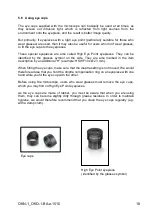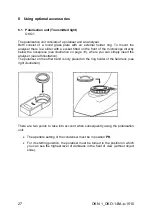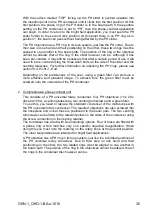
OKN-1_OKO-1-BA-e-1510
30
With the surface marked “TOP” facing up, the PH slider is pushed upwards into
the insertion point on the PH condenser until it clicks into the first position. At this
first position, the phase ring of the PH slider is in the beam path. If the aperture
setting on the PH condenser is se
t to “PH”, then the phase-contrast application
can begin. In order to return to the bright field application, you must push the PH
slider further to the second click position. At this point there is no PH ring as in
position 1; the beam can pass without being affected by the PH slider.
The PH objective has a PH ring in its lens system, just like the PH slider. Due to
their size on one hand and their positioning on the other, these two rings must be
aligned to one another in the beam path. The position of the ring in the objective
cannot be altered, that of the ring in the slider however can be. Although it has
been pre-centred, it may still be necessary that after a certain period of use it will
need to be re-centred using the three Allen bolts on the side of the slider and the
centring telescope.
For further information on adjusting the PH rings, please see
section
8.
4, Point 2 - End.
Depending on the preferences of the user, using a green filter can produce a
more effective and pleasant image. To achieve this, the green filter must be
screwed onto the underside of the PH condenser.
2. Comprehensive phase-contrast unit
This consists of a PH universal rotary condenser, four PH objectives (10x, 20x,
40x and 100x), a centring telescope, two centring turnscrews and a green filter.
To use this, you need to replace the standard condenser of the microscope with
the PH universal rotary condenser. The required objectives are also screwed into
the nosepiece and one of these is positioned in the beam path. The two centring
turnscrews can be fitted to the relevant points on the sides of the condenser using
the screw connection on their spring retainer.
The condenser has a hub with six positioning options. Four of these are fitted with
a phase ring, which matches only one specific objective magnification. When
doing this you must note the marking on the rotary knob at the relevant position.
The other two positions are intended for bright field applications.
A PH objective has a PH ring in its lens system, just like the individual positions of
the PH universal rotary condenser. Due to their size on one hand and their
positioning on the other, the two related rings must be aligned to one another in
the beam path. The position of the ring in the objectives cannot be altered, that of
the rings in the condenser disc however can be.
Summary of Contents for OKN 175
Page 2: ......
Page 7: ...OKN 1_OKO 1 BA e 1510 6 2 Nomenclature...
Page 8: ...7 OKN 1_OKO 1 BA e 1510 Rear view...
Page 9: ...OKN 1_OKO 1 BA e 1510 8 Reflected light unit...
Page 11: ...OKN 1_OKO 1 BA e 1510 10...





































